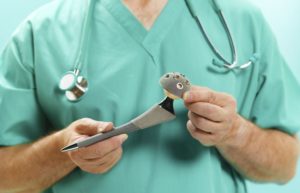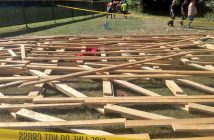Research on early detection of wear and tear of the hip joint implants that keep many people working is set to make significant new progress following an infusion of funding.
Beginning in 2010, University of Canterbury Mechanical Engineer Dr Geoff Rodgers worked with researchers in Christchurch Hospital’s orthopaedic department, including Associate Professor Tim Woodfield and Professor Gary Hooper from the University of Otago, to create an acoustic emission monitoring system that monitors the sound vibrations transmitted from a patient’s hip replacement implants.
Early detection of wear and tear can lead to proactive intervention, reducing the severity of surgery and providing improved patient outcomes.
The monitoring technique measures vibrations that are created by the implant and make it through tissue to the skin’s surface.
By listening to the ultrasonic vibrations of the implant, it is possible to relate them to the condition of the implant.
It is entirely non-invasive and can detect issues when a patient is moving and the implant is loaded.
This compares favourably to existing diagnostic methods such as x-rays, bone scans, and Magnetic Resonance Imaging (MRI), which require specialised, non-portable and expensive equipment, and experienced operators.
These methods, says Rodgers, potentially provide limited diagnostic capability as they usually provide only a static image of a stationary patient, leaving the presence of early loosening or microscopic degradation undetected.
The next stage of research of the project, titled Unique Acoustic Signatures to Diagnose Impending DOOM (Dysfunction of Osteo-Mechanics), is possible thanks to a Marsden Grant of $300,000.
While acoustic emission monitoring itself is a promising early detection method for implant dysfunction, it only captures one aspect of implant mechanics.
To date, says Rodgers, acoustic signals have only been broadly related to the type of patient motion as there has been no measurement of patient gait, limb angles or method of approximating implant loading.
“Many key metrics remain unknown due to the inability to measure these quantities directly.
“To produce a detailed understand of in vivo [within a living organism]implant mechanics, it is necessary to determine the joint angles, muscle forces and implant loads occurring at the time of acoustic recording.”
The underpinning hypothesis of the next stage of the research is that the combination of patient gait analysis, biomechanical modelling and acoustic emission monitoring, when a patient’s joint is in motion, can be used to develop a comprehensive understanding of in vivo implant mechanics and detect impending dysfunction of osteo-mechanics, Rodgers says.
Hooper says joint replacement surgery has the ability to significantly improve the lifestyle of patients who have disabling arthritis.
The requirement for this surgery is increasing rapidly with predictions of a 300 per cent increase in knee replacement by 2030.
“All of these replacements wear with time and are likely to fail.
“Currently we have no methods for measuring how the implant is functioning in vivo and whether failure is imminent.
“This research will help enable clinicians to both assess the risk and modes of failure which can then be translated into improving patient and implant factors responsible for failure.
“Reducing implant failure and the high cost of revision surgery has major implications for health funding,” he says.
The new research will also see Inertial Measurement Units (IMU) attached to a patient’s limbs to measure metrics such as joint shock, limb accelerations and rotations.
These small, non-invasive wireless sensors can be strapped to a patient’s foot, lower limb and pelvis to record the motion at those locations.
The development of a biomechanical model of the lower limb in OpenSim open source software will enable the interpretation of the results.
Thanks to a new collaboration with Dr Justin Fernandez, at the Auckland Bioengineering Institute (University of Auckland), the project will leverage off his extensive experience in multiscale musculoskeletal modelling which enables direct estimation of muscle forces and joint reaction loads.
No other group is combining acoustic emission monitoring with such extensive biomechanical modelling, Rodgers claims.
“We believe this multiple sensor approach and associated modelling – the missing link – will lead to significant new insights into implant mechanics and could significantly improve patient care, by providing an additional diagnostic method to orthopaedic surgeons.”
Rodgers adds that outcomes are not limited to non-invasive diagnostics of the condition of joint replacement implants.
Acoustic sensing methods are broadly applicable in other areas: lung, bowel and intestine applications have all been investigated to an early stage by researchers internationally.




